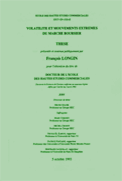

This thesis focuses on the extreme movements of the stock market. Most of the research works in finance deal with the study of the average properties of financial asset prices such as expected return and expected volatility. In many studies extreme values are considered as abnormal and then rejected. The discounting of these agitated periods may question the results of the tests of theoretical models and the stylized facts drawn from empirical studies. Unlike these studies I take into account especially extreme observations. This is the originality of my work. Considering price changes in financial markets I show that the statistical properties of extreme price movements are better known that those of usual movements. Extremes contain a lot of information and allow one to derive properties about the general process of price changes. My thesis is organized in essays and presents both theoretical and empirical works.
In the first essay, I show that the extreme movements of the stock market, defined as the maximal and minimal returns observed over a given time-period, obey a quite precise statistical law. Extreme theory of value tells us that the form of this law is obtained for a very great number of random classes of process in particular for the processes usually used in financial theory. The extreme values theorem thus provides us a very general result. Empirically, the adjustment of the distribution of the extremes to the data of extreme returns observed on New York Stock Exchange is statistically good. I am interested then in the booms and the stock exchange crashes. A stock market crash, for example, corresponds certainly to a minimal return. But the reverse is not true: all minimal returns do not correspond to stock market crashes. I use two methods to define a stock exchange crash: a quantitative method using a threshold and a qualitative method founded on the opinion of the participants in the market found in the New York Times. The tests show that the two types of minima, crashes and not-crashes, are probably drawn from the same distribution. Therefore, from a statistical point of view, the stock exchange crashes are simply "bad" draws of a distribution and not abnormal events. A similar conclusion applies to the booms. Finally, these empirical results are used to discriminate the various statistical models for returns. I use the information contained in extreme returns to specify the nature of the process of entire returns.
The second essay deals with the instability of the American equity market. We define a measure of instability based on the distribution of the extremes. We find empirically that the period 1836-1914 is more stable than the period 1914-1990. The instability of this century may be attributed to the moral hazard problem due to the intervention of the Central Bank as a lender of last resort.
The third essay is interested in the impact of the extreme values in expected volatility of the financial markets. Empirically, using a model TARCH (for Threshold ARCH), I highlight the threshold effect in expected volatility: the degree of persistence of the large shocks is less than that of the small shocks. In other words, after a large shock, volatility increases but relatively less than after a small shock, and returns quickly towards its long-term level. I explain the threshold effect using a model of asymmetric information. In particular, I show that the presence of informed investors induced a threshold effect in the expected volatility of the market prices: whereas the process of information is a process ARCH (by assumption), the process of the market prices is a process TARCH.
 Return to the publication list
Return to the publication list
The asymptotic distribution of extreme stock market returns
Is the correlation in international equity returns constant: 1960-1990 ?
The threshold effect in expected volatility : a model based on asymmetric information